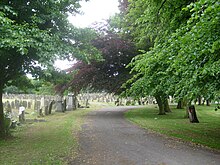Toxteth Park Cemetery

Toxteth Park Cemetery
|
|
| Details | |
|---|---|
| Established | June 1856 |
| Location | Liverpool, Merseyside |
| Country | England |
| Type | Public |
| Owned by | Liverpool City Council |
Toxteth Park Cemetery is a graveyard on Smithdown Road, Liverpool, United Kingdom. It was opened on Monday 9 June 1856. It was the responsibility of the Toxteth Park Burial Board, which had been established by at least 1855.
The opening ceremony was performed by the then Lord Bishop of Chester, and the first interment took place, that of an Elizabeth Watling on 17 June 1856.
The cemetery was built with consecrated and unconsecrated areas, and the layout, featuring walks, was by a "Mr Gay of Bradford cemetery".
It was taken over by Liverpool Corporation on 1 January 1905.
The cemetery's records are held on microfilm in the Liverpool Record Office, and provide the Burial Registers and the Order Books.
Various buildings at the cemetery are Grade II listed buildings. In addition to the significant number of obelisk and Celtic cross gravestones in the cemetery, there is a derelict chapel, and a pair of lodges or gatehouses at the Smithdown Road entrance. The cemetery also contains Toxteth War Memorial.
To the rear, the cemetery bounds the back gardens of houses on Arundel Avenue, and can be accessed through turnstiles in an ornate gateway set back from that road at the end of a short lane. On the easterly lodge at the main entrance at Smithdown Road there is a sign with provision for the insertion of digits indicating the time of evening at which these rear entrance turnstiles will be closed, but for some time this sign has been disused, as this lodge also appears to be (the westerly lodge being inhabited and, as of spring 2009, up for auction.)
The cemetery contains the war graves of 274 Commonwealth service personnel, 227 from World War I and 45 from World War II. The largest group are in a War Graves plot containing 69 graves, the names of those in the plot being listed on a Screen Wall curb memorial, while other graves are dispersed throughout the cemetery. Fifty of the British dead are soldiers of the King's Liverpool Regiment.
...
Wikipedia
